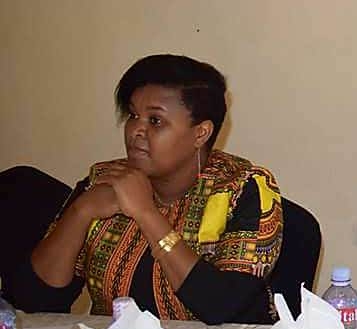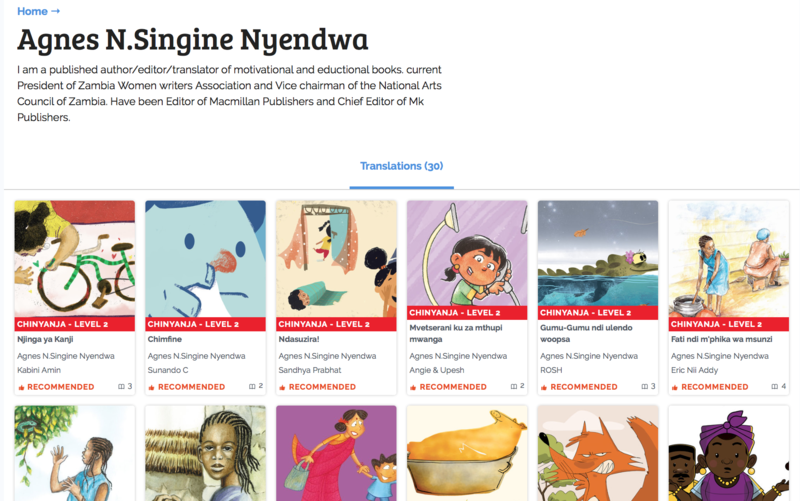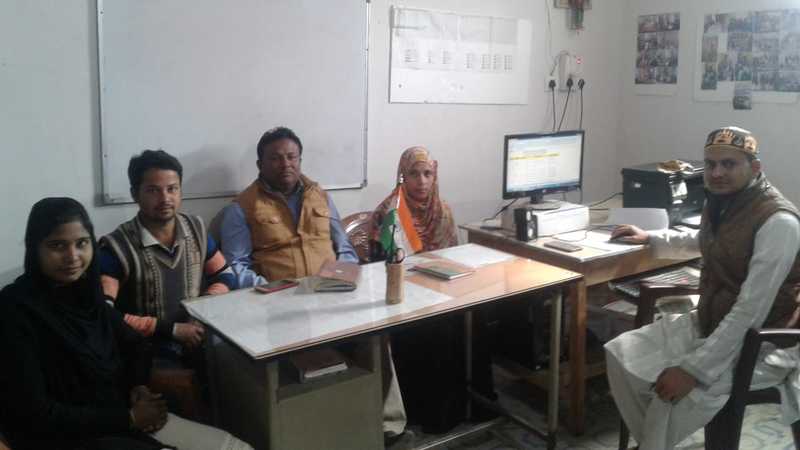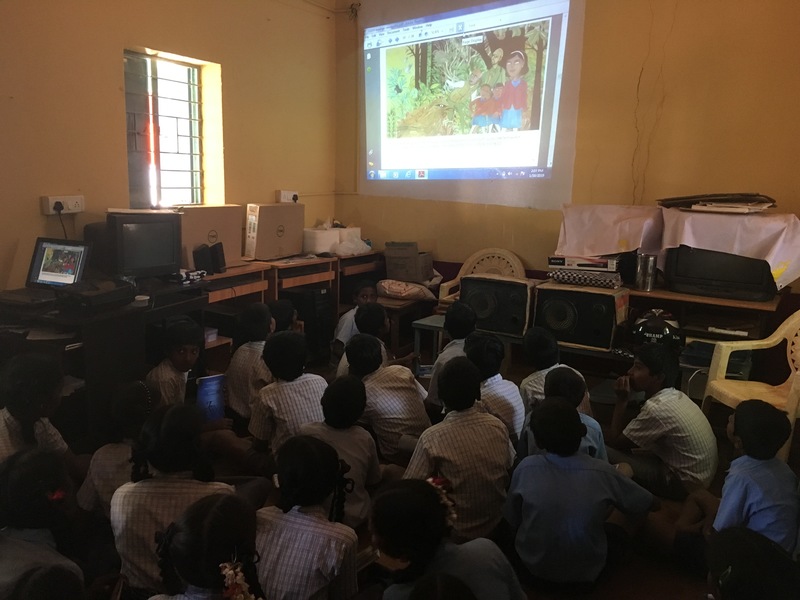#FreedomtoRead 2019 Agnes N.S. Nyendwa from Zambia on translating stories to Chinyanja
Posted by Amna Singh on February 16, 2019 Writer, translator, editor and poet Agnes N.S. Nyendwa has always been best friends with books — right from her days as a warehouse clerk where she read up all the books in stock to her rise to an editor with publishing houses. Along the way, she was always passionate about her mother tongue Chinyanja, a language belonging to the Bantu language system of Africa and spoken widely across Malawi, Zambia and the Mozambique. Agnes is translating books on the StoryWeaver platform to her mother tongue and tells us in an email interview on why children need to read more stories in Chinyanja in her country and how she plans to make sure that more of them have access to these books.
Writer, translator, editor and poet Agnes N.S. Nyendwa has always been best friends with books — right from her days as a warehouse clerk where she read up all the books in stock to her rise to an editor with publishing houses. Along the way, she was always passionate about her mother tongue Chinyanja, a language belonging to the Bantu language system of Africa and spoken widely across Malawi, Zambia and the Mozambique. Agnes is translating books on the StoryWeaver platform to her mother tongue and tells us in an email interview on why children need to read more stories in Chinyanja in her country and how she plans to make sure that more of them have access to these books.
Tell us a bit about yourself?
I am a writer, translator, editor, poet (English and Chinyanja), president of the Zambia Women Writers Association and Vice chairman of the National Arts Council, and have been in publishing circles since 1994. I started off as a Warehousing clerk being the first employee to have been engaged in that position at Macmillan Publishers Zambia Limited. I studied Purchasing and Supply (CIPS) and emerged as best student in the field. In my job as a warehouse clerk, I became friends with a bunch of books which I took time to read and enjoy. I cultivated the culture of reading each and every book that was in the warehouse. I later knew each book by its content and what to present if anyone wanted to buy any book in any field. I made it a point after that to read any new title as it came.
Due to the immense interest that I had in books, I was promoted to be Assistant Editor when the Zambia curriculum transitioned into a new one. My first assignment was to handle local languages because the whole project was a challenge. I managed to have the project take off and in the process I was seconded for an in-house training at Oxford Macmillan Education in the UK, which later catapulted me to be an Editor of the organisation back home.
What is your personal relationship to Chinyanja and to translation?
Apart from learning the language at school, Chinyanja/Chichewa is actually my mother’s language. As it is truly my mother’s tongue – my parents (my mother being a teacher by profession) made sure we honed the skill of speaking and writing it. They would not allow us to mix any other language when speaking with them, let alone writing to them. We were encouraged to read Chinyanja/Chichewa books, which I certainly do even now. This made us know the language without measure. Our home was our training ground for the local language where neighbours would be amazed at how we spoke it even when we grew up in a low density area where only people with high education lived. Friends would laugh at our tongue because sometimes they would request us to interpret the words we spoke.
Later in life I still had a challenge convincing my husband that the words I spoke were actual Chinyanja/Chichewa. He thought that as a family we had developed a language that we alone would understand not until I bought a dictionary from a bookstore in Malawi. He took time to refer to it on every word that he thought was specific to my family. He was amazed to have found the very words in the dictionary.
That is the power of teaching a child her mother tongue. It is easy for me to understand other languages because I can relate them to my own. I now thank my parents for imparting that priceless skill to me. I look at myself as one of those who is open to learning and embraces criticisms when it comes to the local languages. I have written and translated a number of books that are currently being read in schools.
You have been translating STEM stories. Describe the process to us. Would this process be different for a joyful picture book?
The process is not easy when you are just starting as a translator of STEM books. The process is quite challenging because of the absence of indigenous terminologies for certain concepts and words in general. STEM books have a lot of these non-indigenous terms. But by using the meaning approach and transliteration, the challenge is quite eased. I actually enjoy translating them because I get to understand and impart the terms in a way that are simple to grasp.
I don’t find picture books to be any different from other story books because each book presents its own challenges, some may be grammatical or orthographical but rising to the challenge is what makes translating any book unique and adventurous.
How do you plan to take the Chinyanja stories to the children?
In our society, doing a venture totally free can be quite challenging because the conveyor of the message needs finances to operate. I would love to have every child who is stationed in a Chinyanja belt to get hold of these wonderful stories. It is a fact that a bigger chunk of my country cannot access internet which can be a transmission port for these books. I need them printed in hard copies so that they are distributed for children to have and read wherever they are, with friends and family.
My plan is to raise funds that can allow me to print and probably sell at a nominal price and for them to be spread where their relevance is. If I can find funds that can allow me to print and transport the books, I don’t think there will be any need to sell them but to distribute them to libraries and have them approved for use in schools. For those who are able to browse on the internet, sending the link to people I know and other official arts and educational platforms is helping to spread the books. I have actually started sending the link and people are reading them.
What do you usually read? Which language do you prefer to read in?
Yes I do read quite a lot. A good story is what prompts my language of preference. I do read in Chinyanja and English as well as other Zambian languages that I have quite a considerable amount of knowledge.
A glimpse of the stories Agnes is translating to Chinyanja on StoryWeaver. You can read these stories here.

Thank you Agnes! May your tribe increase!
Write in to us at [email protected] if you want us to add your native language.
Be the first to comment.#FreedomtoRead 2019 Azad India Foundation on building a hyperlocal library of 100 Surjapuri stories
Posted by Amna Singh on February 16, 2019Azad India Foundation (AIF) was founded by Yuman Hussain in 1998 to seed initiatives in education & primary health care. The organisaton's activities reach out to marginalised women, adolescents and underserved children from rural and urban areas of Kishanganj district in Bihar. AIF has learning centres at 73 villages in three blocks of Pothia, Kishanganj and Thakurganj in Kishanganj, impacting 3,500 + children directly in the area. The children in AIF's centres are aged between 6-9 yeas and are either school dropouts or attending Madrassas. The centre's syllabus includes Hindi, English, Science and Maths. The main aim of the initiative is to ensure that children are ready to merge with mainstream education in state-run schools by grade 4.
AIF is also our first partner translator to have completed its goal of translating 100 StoryWeaver books into Surjapuri. Surjapuri is spoken in pockets of Bihar, West Bengal, Assam and Bangladesh by 1.2 million people. In Bihar, the language is spoken in Koshanganj, Katihar, Purnia and Araria districts. In an email interview Yuman Hussain tells us why creating a hyperlocal library in Surjapuri is important and how AIF managed to reach its goal of 100 books in collaboration with its project and cluster coordinators.
Tell us more about Azad India Foundation?
Azad India Foundation (AIF) has been working in Kishanganj district of Bihar from 2001. It started its activities with a non-formal education and vocational training centre for women. Over the years, AIF’s focus has been on the development of poor and marginalized children, adolescents and women. Our activities are in the fields of women’s literacy, formal school education, non-formal education, rural employment, income generating skills, SHG formation, and community health programmes. Currently, we are directly working with 3,500 children in the primary classes through learning centres in 73 villages of four blocks — Kochadaman, Pothia, Kishanganj and Thakurganj.
What are the long-term effects of a lack of easy access to resources in mother tongue languages for the communities that you work with?
Surjapuri is local language spoken among a large section of people in the Seemanchal area (Kishanganj, Araria, Purea and Katihar) of Bihar. Unfortunately, we have not seen any books or resources available in the local language for the children. There is a possibility that these languages will be lost over a period of time as more and more people now speak Hindi. In fact, when we started translating books in Surjapuri and shared them with the children and community members they were unable to recognize their own written language.
What are the benefits of creating a local digital library of joyful storybooks in Surjapuri?
Creating a hyperlocal library at StoryWeaver will help our children have access to and preserve Surjapuri as their language. It would also enable them develop their reading skills and enjoy stories from all over the world in their own dialect. The digital library is free besides being easily accessible to every one. The mobile friendly feature has made it possible for the books to reach even remote corners of the country.

Tell us more about your team of conributors and how you managed to translate and publish the 100 Surjapuri stories?
The stories were translated by the team of project Badhte Kadam comprising cluster coordinators Aslam, Chand, Juhi and teachers. They were really excited about creating Surjapuri stories as it gave them an opportunity to contribute to the preservation of their own language. Muzzamil, who is the project head, reviewed the stories. The stories were chosen according to the themes and levels of the children accessing them. The toughest part was the typing and uploading of the stories that was done diligently by Saqlain, our computer operator. AIF is really proud and thankful to its team members for completing this programme within the stipulated time period with sincerity and enthusiasm. We will continue adding more stories and hope to bring the joy of reading to all children.
 AIF's Team Badhte Kadam
AIF's Team Badhte Kadam
How does Azad India Foundation plan to use this digital library of a 100 books?
AIF plans to introduce these stories among the children at our learning centres. We are also spreading the message through social media about the StoryWeaver platform so that the community can access, use these stories and help in building this digital library further with many more books. This is a small step towards the preservation of local languages for which we are grateful to the StoryWeaver platform.
You can read the Surjapuri stories translated by Azad India Foundation here.
Be the first to comment.Digital Libraries in schools of rural Karnataka
Posted by Vineetha Menon on February 04, 2019
Suganya, from the Partnerships team, takes us on a journey to Tumkur where India Literacy Project is implementing a Multi-Dimensional Learning Spaces program with the government schools.
Getting there
The two-hour ride to Tumkur through traffic and on roads under-construction had taken a toll on our energy levels. But meeting children filled with enthusiasm for the read-aloud instantly put a smile back on our faces.
We were greeted by Latha, an India Literacy Project (ILP) Facilitator. She has been instrumental in implementing StoryWeaver content as a part of their Multi Dimensional Learning Space (MDLS) programme. Over 16 facilitators who work across 30 schools in Tumkur, Karnataka, identify schools in need, coordinate with partner organisations and develop a programme to help children not only with academics but also overall personality development. They provide schools with digital infrastructure, reading material and teacher guides, and also help them implement the programme in the classroom.
Story reading
Children were excited to get started with the read-aloud session. They had picked Smile Please for this. One of the children volunteered to read the story, and the others joined in. Whenever she had difficulty with a sentence or the pronunciation of a word, the class teacher and the ILP facilitator chipped in to help her out.
We were awed by the children’s enthusiasm and decided to do an impromptu reading session for them. One of our team members stepped in and interacted with the children in Kannada, doing another reading. It was way past the children’s lunch time, but they wanted their fill of stories first.
While the students were getting ready to enjoy their mid-day meal, we bid goodbye and continued our journey to visit more children.
More stories…
Once we reached the next school, we met with the headmaster and the ILP facilitator, Tejaswini. Teachers there have found it easier to introduce science and mathematics concepts using our STEM books. Children operate the computer and the projector during their free time to read stories on their own.
Without further ado, we began another read-aloud session with the children. This time, children had decided on Welcome to the Forest. Children enjoyed the narrative and also gained insights about the forest and animals that call it home. We asked the children, “What is your favourite book and which story do you enjoy reading aloud in class?”. We were happy to hear varied responses, but Dum Dum-a-Dum Biryani! turned out to be everyone’s favorite.
We were glad to see the children read and relate to the characters portrayed in our books. We believe that an incredible future awaits the children. With partners like ILP, we get that much closer to making our vision a reality.
Be the first to comment.